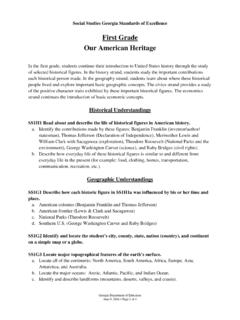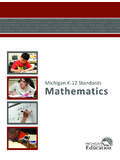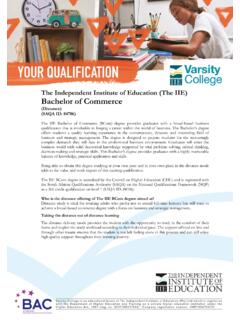Transcription of Georgia Standards of Excellence
1 Georgia Standards of Excellence Mathematics Standards Kindergarten Fifth Grade Georgia Department of Education K-12 Mathematics Introduction The Georgia Mathematics Curriculum focuses on actively engaging the students in the development of mathematical understanding by using manipulatives and a variety of representations, working independently and cooperatively to solve problems, estimating and computing efficiently, and conducting investigations and recording findings. There is a shift towards applying mathematical concepts and skills in the context of authentic problems and for the student to understand concepts rather than merely follow a sequence of procedures.
2 In mathematics classrooms, students will learn to think critically in a mathematical way with an understanding that there are many different ways to a solution and sometimes more than one right answer in applied mathematics. Mathematics is the economy of information. The central idea of all mathematics is to discover how knowing some things well, via reasoning, permit students to know much else without having to commit the information to memory as a separate fact. It is the connections, the reasoned, logical connections that make mathematics manageable.
3 As a result, implementation of Georgia Standards of Excellence places a greater emphasis on problem solving, reasoning, representation, connections, and communication. Toward greater focus and coherence Mathematics experiences in early childhood settings should concentrate on (1) number (which includes whole number, operations, and relations) and (2) geometry, spatial relations, and measurement, with more mathematics learning time devoted to number than to other topics. Mathematical process goals should be integrated in these content areas.
4 Mathematics Learning in Early Childhood, National Research Council, 2009. The composite Standards [of Hong Kong, Korea and Singapore] have a number of features that can inform an international benchmarking process for the development of K 6 mathematics Standards in the First, the composite Standards concentrate the early learning of mathematics on the number, measurement, and geometry strands with less emphasis on data analysis and little exposure to algebra. The Hong Kong Standards for grades 1 3 devote approximately half the targeted time to numbers and almost all the time remaining to geometry and measurement.
5 Ginsburg, Leinwand and Decker, 2009. Because the mathematics concepts in [ ] textbooks are often weak, the presentation becomes more mechanical than is ideal. We looked at both traditional and non-traditional textbooks used in the US and found this conceptual weakness in both. Ginsburg et al., 2005. There are many ways to organize curricula. The challenge, now rarely met, is to avoid those that distort mathematics and turn off students. Steen, 2007. For over a decade, research studies of mathematics education in high-performing countries have pointed to the conclusion that the mathematics curriculum in the United States must become substantially more focused and coherent in order to improve mathematics achievement in this country.
6 To deliver on the promise of common Standards , the Standards must address the problem of a curriculum that is a mile wide and an inch deep. These Standards are a substantial answer to that challenge. Richard Woods, State School Superintendent July 2016 Page 2 of 43. All Rights Reserved Georgia Department of Education It is important to recognize that fewer Standards are no substitute for focused Standards . Achieving fewer Standards would be easy to do by resorting to broad, general statements. Instead, these Standards aim for clarity and specificity.
7 Assessing the coherence of a set of Standards is more difficult than assessing their focus. William Schmidt and Richard Houang (2002) have said that content Standards and curricula are coherent if they are: articulated over time as a sequence of topics and performances that are logical and reflect, where appropriate, the sequential or hierarchical nature of the disciplinary content from which the subject matter derives. That is, what and how students are taught should reflect not only the topics that fall within a certain academic discipline, but also the key ideas that determine how knowledge is organized and generated within that discipline.
8 This implies that to be coherent, a set of content Standards must evolve from particulars ( , the meaning and operations of whole numbers, including simple math facts and routine computational procedures associated with whole numbers and fractions). to deeper structures inherent in the discipline. These deeper structures then serve as a means for connecting the particulars (such as an understanding of the rational number system and its properties). (emphasis added). These Standards endeavor to follow such a design, not only by stressing conceptual understanding of key ideas, but also by continually returning to organizing principles such as place value or the properties of operations to structure those ideas.
9 In addition, the sequence of topics and performances that is outlined in a body of mathematics Standards must also respect what is known about how students learn. As Confrey (2007) points out, developing sequenced obstacles and challenges for students absent the insights about meaning that derive from careful study of learning, would be unfortunate and unwise. In recognition of this, the development of these Standards began with research-based learning progressions detailing what is known today about how students' mathematical knowledge, skill, and understanding develop over time.
10 Understanding mathematics These Standards define what students should understand and be able to do in their study of mathematics. Asking a student to understand something means asking a teacher to assess whether the student has understood it. But what does mathematical understanding look like? One hallmark of mathematical understanding is the ability to justify, in a way appropriate to the student's mathematical maturity, why a particular mathematical statement is true or where a mathematical rule comes from.












